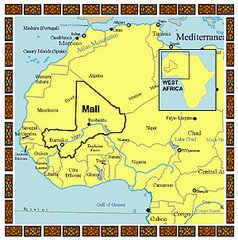Most of us like to get a tester spoon of that chocolate hazelnut gelato before we buy it; to run the flavor over the tongue and decide yes, I do in fact want to invest in a more prolonged experience. The Peace Corps apparently recognizes this human tendency and sent all the trainees to our real sites this past week to get a sample of where we will be living for the next two years of our lives.
So last Tuesday I met with Abdouleye, a farmer from my region who will serve as my "homologue," a go-to-person and guide to help me work in agriculture in my region. He is a slight man with a furrowed brow that quickly flattens into a grin. We went to the bus station together and sat on some old crates to wait a few hours for the bus to fill. The bus station swarms with men and women balancing huge baskets and platters of fried cakes, bananas, toothpaste, jewelry and radios, all teetering with impossible grace on the tops of their heads. Finally the bus "boiled" (Bambara is a language that I have dubbed a "homonymic whirlpool" because each word has twenty meanings. The word wuli means to plow a field, to boil water, to stand up, to wake up, and for a bus to leave), and we sat in cramped seats, sweating in the stagnant air for seven hours until we reached our village in the South East of Mali: M'Pedougou.
M'Pedougou is a village of about 650 people of the Senufo ethnic group, situated on a main road; straddling the vein of modernity but still firmly rooted in tradition. When I arrived, I met my host family, Jakilia Bengaly and his three wives, beautiful people with big white smiles and thick Senufo accents that I don't understand. They gave me my new name: Sita Bengaly, and we sat out by the roadside in front of Jakilia's little butiki (store). Next they took me to my house, weaving through the village on a little path past thatched huts and gardens and big trees. There was my house on the edge of town: a mud brick cottage with a thatched structure outside for shade. Big vines and flowers fill my yard, and I plunked down in my hammock, realizing that this is my new HOME. I went to the pump and got water, set up my mosquito net, and went to meander in the village.
It turns out that well, Senufo people speak Senufo. Most of them have learned Bambara as a second language, but they speak Senufo amongst themselves and when given the choice. I spent a good portion of my week in village sitting around listening to the crazy sounds of Senufo and wondering if I will ever be able to learn a language that sounds like Chinese, but that has no written materials for me to learn from. We'll see. I will try.
The majority of the villagers are subsistence farmers farming millet, sorghum, corn, okra and peanuts. My goal as a volunteer will be to help them develop better gardening and farming techniques, increased compost production, and to do what I can to enable them to improve their quality of life, in whatever capacity I can. At this point I still have no idea what I will be doing, concretely, when I get to village and have no structure, no "job," nothing but the sunrise and the sunset to structure my day around. It will be a radical change, that's what I do know.
Subscribe to:
Post Comments (Atom)



1 comment:
Hello!
I have been reading your blog and holding on to every word like a delicate morsel. Thank you! You give me great inspiration. I just received my staging kit today. I fly out to Phily as well. I am working on constructing my blog and will share the address with you once it is up an running. For now I am wondering how you transfered your digital photos to a computer in Mali. Any and all tips are much appreciated!
All the best,
Kristina (Josh's other half)
Post a Comment